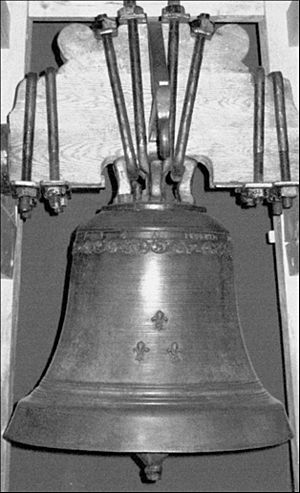Battle at Chignecto facts for kids
Quick facts for kids Battle at Chignecto |
|||||||
|---|---|---|---|---|---|---|---|
| Part of Father Le Loutre's War | |||||||
 Charles Lawrence |
|||||||
|
|||||||
| Belligerents | |||||||
| Mi'kmaq militia Acadian militia |
|||||||
| Commanders and leaders | |||||||
| Jean-Louis Le Loutre Louis de La Corne Louis Le Neuf de la Valiere Joseph Broussard (Beausoliel) Chief Étienne Bâtard Father Charles Germain |
Charles Lawrence John Gorham Captain John Rous Silvanus Cobb Horatio Gates Captain William Clapham Colonel Peregrine Lascelles John Salusbury Hugh Warburton Joseph Gorham Joshua Winslow John Brewse (wounded) Captain William Rickson Francis Bartelo † Henry Grace (POW) |
||||||
| Strength | |||||||
| 300 Mi'kmaq and Acadian militia | 700 British regulars and New England Rangers | ||||||
| Casualties and losses | |||||||
| 7-8 Mi'kmaq | 20 killed; 3 killed, 12 missing | ||||||
The Battle at Chignecto was an important fight during Father Le Loutre's War. It happened on September 3, 1750, in Chignecto, Nova Scotia. This battle was the first time the British tried to take control of the top of the Bay of Fundy since the Battle of Grand Pré three years earlier.
The British forces were led by Charles Lawrence, John Gorham, and Captain John Rous. They fought against a group of Mi'kmaq and Acadians. This group was led by Jean-Louis Le Loutre and Joseph Broussard (also known as Beausoliel).
Why the Battle Happened

Even though the British had taken over Acadia in 1710, most people living there were still Catholic Acadians and Mi'kmaq. The Mi'kmaq people, who were part of the Wabanaki Confederacy, often protected their lands. They did this by raiding British settlements along the border of New England and Acadia.
To stop new British settlements, the Mi'kmaq attacked early British towns like Shelburne (in 1715) and Canso (in 1720).
Father Le Loutre's War began when Edward Cornwallis arrived in June 1749. He came with 13 ships to start the city of Halifax.
Within 18 months of starting Halifax, the British built forts in major Acadian communities. These included Fort Edward in present-day Windsor, Fort Vieux Logis in Grand Pre, and Fort Lawrence in Chignecto. There was already a British fort at Annapolis Royal.
After a raid on Dartmouth in 1749, Governor Cornwallis issued a strong order to stop the attacks. The Siege of Grand Pré was the first big fight in the area after the Dartmouth raid.
The Battle Itself
In April 1750, Charles Lawrence tried to set up a base at Chignecto. But Jean-Louis Le Loutre led 70 Mi'kmaq and 30 Acadians to burn the village of Beaubassin. This stopped Lawrence from using its supplies to build a fort.
Lawrence had to retreat, but he came back in September 1750.
On September 3, 1750, Captain John Rous, Lawrence, and Gorham led over 700 British soldiers. These soldiers included members of the 40th, 45th, and 47th Regiments.
They arrived at Chignecto, where Mi'kmaq and Acadians were waiting. The defenders had built a low wall of earth and logs, called a breastwork. They used this to fight against the British landing. Twenty British soldiers were killed, and several Mi'kmaq were also killed. Captain Francis Bartelo was killed in this battle.
Le Loutre's militia eventually pulled back to Beausejour. As they left, they burned the remaining Acadian crops and houses.
What Happened Next
After the battle, the British built Fort Lawrence at Chignecto.
On October 15, a group of Mi'kmaq, pretending to be French officers, tricked Edward How, a member of the Nova Scotia Council. This trap was set by Étienne Bâtard. How was badly wounded and died a few days later.
The Mi'kmaq people and Acadians continued to carry out many raids. They attacked places like Dartmouth and Halifax.
Gallery
-
Louis de la Corne, Chevalier de la Corne, Commander at Beausejour
-
Horatio Gates (45th Regiment)
-
Joshua Winslow - portrait while serving at Fort Lawrence (1755)
-
45th Regiment of Foot By David Morier, 1751
-
Peregrine Lascelles (47th Regiment)
-
Winckworth Tonge (45th Regiment)










